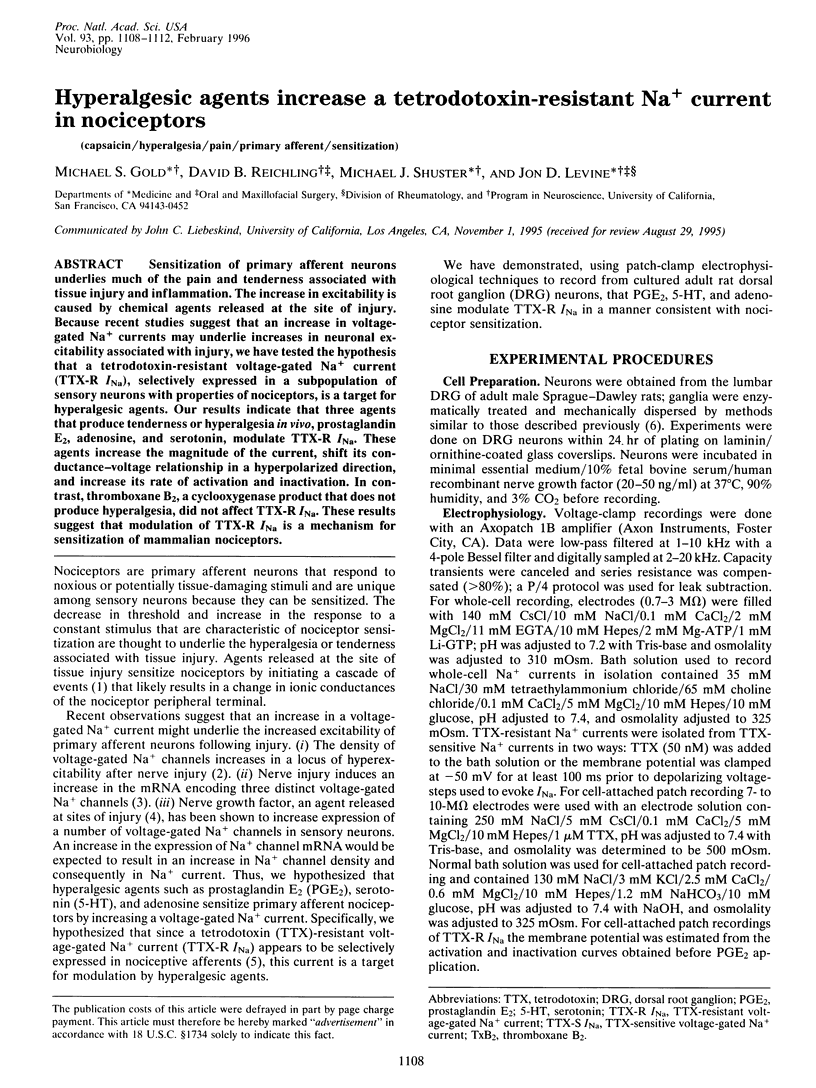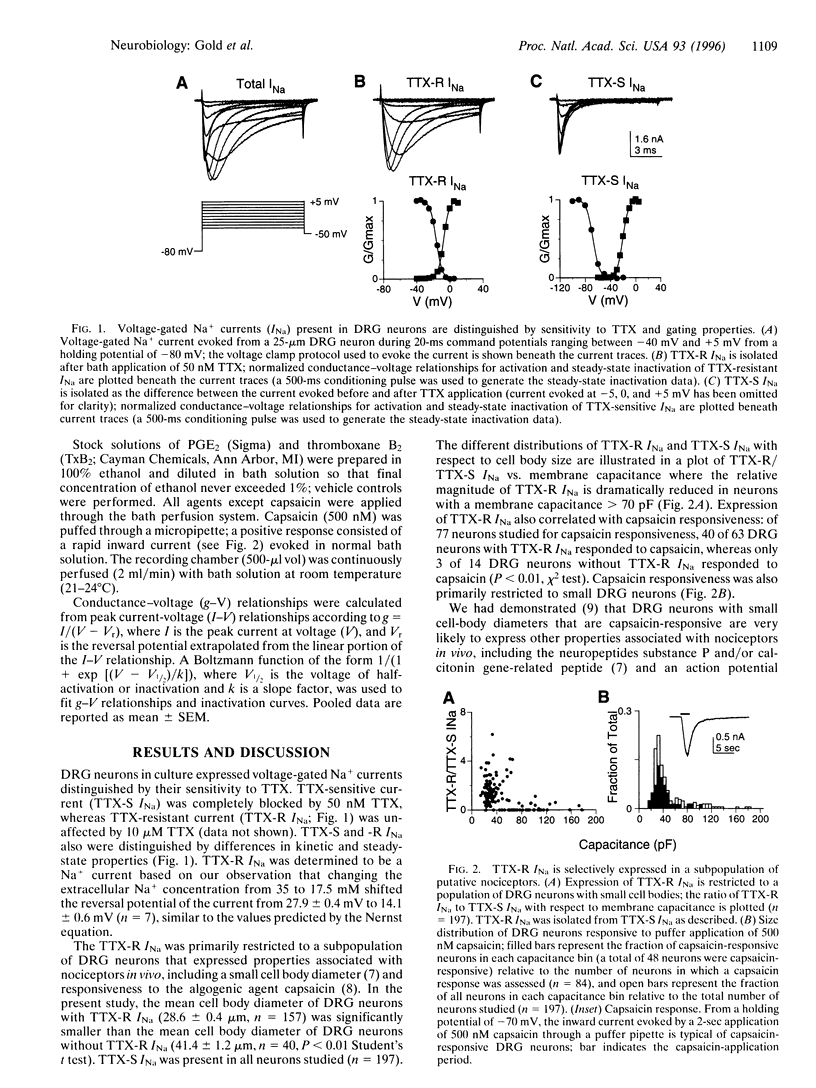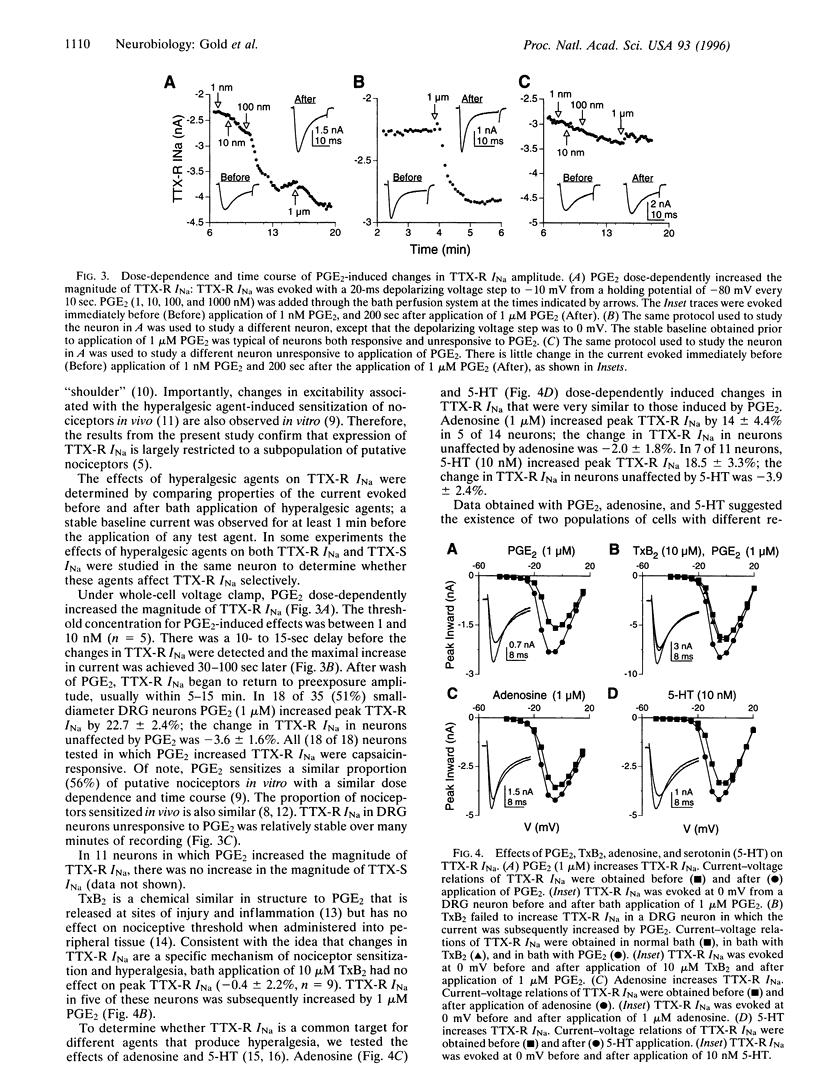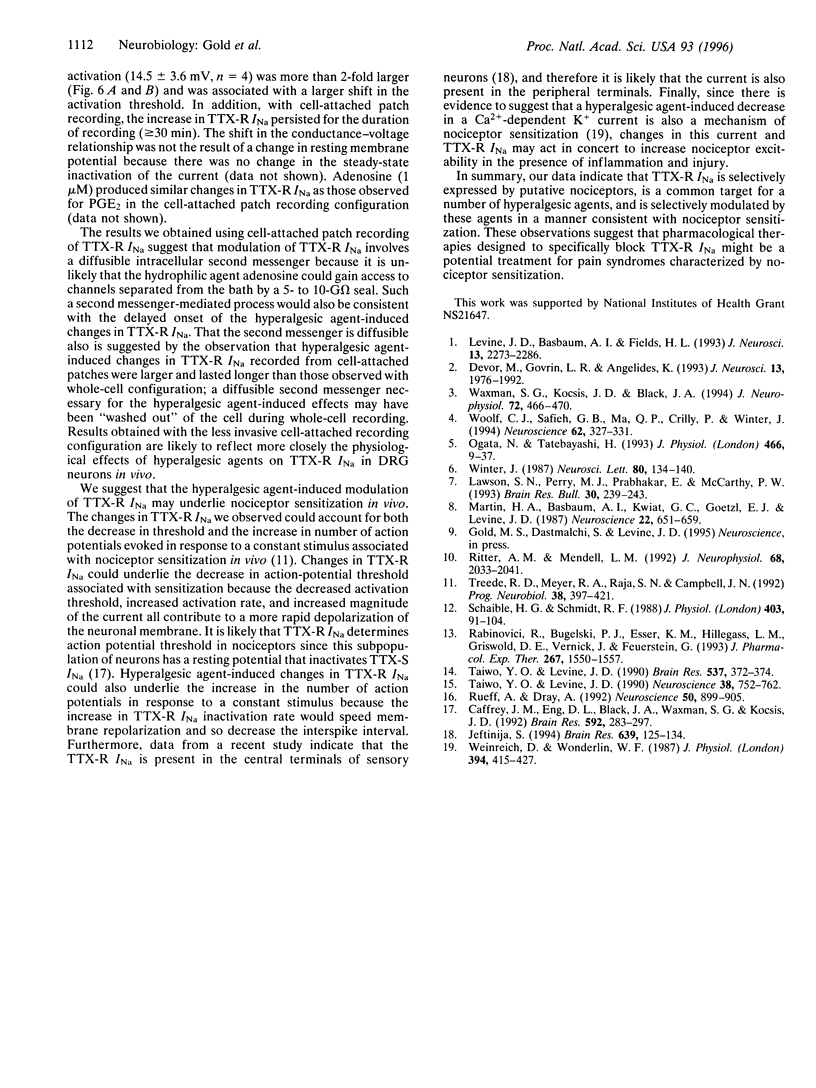Abstract
Sensitization of primary afferent neurons underlies much of the pain and tenderness associated with tissue injury and inflammation. The increase in excitability is caused by chemical agents released at the site of injury. Because recent studies suggest that an increase in voltage-gated Na+ currents may underlie increases in neuronal excitability associated with injury, we have tested the hypothesis that a tetrodotoxin-resistant voltage-gated Na+ current (TTX-R INa), selectively expressed in a subpopulation of sensory neurons with properties of nociceptors, is a target for hyperalgesic agents. Our results indicate that three agents that produce tenderness or hyperalgesia in vivo, prostaglandin E2, adenosine, and serotonin, modulate TTX-R INa. These agents increase the magnitude of the current, shift its conductance-voltage relationship in a hyperpolarized direction, and increase its rate of activation and inactivation. In contrast, thromboxane B2, a cyclooxygenase product that does not produce hyperalgesia, did not affect TTX-R INa. These results suggest that modulation of TTX-R INa is a mechanism for sensitization of mammalian nociceptors.
Full text
PDF




Selected References
These references are in PubMed. This may not be the complete list of references from this article.
- Caffrey J. M., Eng D. L., Black J. A., Waxman S. G., Kocsis J. D. Three types of sodium channels in adult rat dorsal root ganglion neurons. Brain Res. 1992 Oct 2;592(1-2):283–297. doi: 10.1016/0006-8993(92)91687-a. [DOI] [PubMed] [Google Scholar]
- Devor M., Govrin-Lippmann R., Angelides K. Na+ channel immunolocalization in peripheral mammalian axons and changes following nerve injury and neuroma formation. J Neurosci. 1993 May;13(5):1976–1992. doi: 10.1523/JNEUROSCI.13-05-01976.1993. [DOI] [PMC free article] [PubMed] [Google Scholar]
- Jeftinija S. The role of tetrodotoxin-resistant sodium channels of small primary afferent fibers. Brain Res. 1994 Mar 7;639(1):125–134. doi: 10.1016/0006-8993(94)91772-8. [DOI] [PubMed] [Google Scholar]
- Lawson S. N., Perry M. J., Prabhakar E., McCarthy P. W. Primary sensory neurones: neurofilament, neuropeptides, and conduction velocity. Brain Res Bull. 1993;30(3-4):239–243. doi: 10.1016/0361-9230(93)90250-f. [DOI] [PubMed] [Google Scholar]
- Levine J. D., Fields H. L., Basbaum A. I. Peptides and the primary afferent nociceptor. J Neurosci. 1993 Jun;13(6):2273–2286. doi: 10.1523/JNEUROSCI.13-06-02273.1993. [DOI] [PMC free article] [PubMed] [Google Scholar]
- Martin H. A., Basbaum A. I., Kwiat G. C., Goetzl E. J., Levine J. D. Leukotriene and prostaglandin sensitization of cutaneous high-threshold C- and A-delta mechanonociceptors in the hairy skin of rat hindlimbs. Neuroscience. 1987 Aug;22(2):651–659. doi: 10.1016/0306-4522(87)90360-5. [DOI] [PubMed] [Google Scholar]
- Ogata N., Tatebayashi H. Kinetic analysis of two types of Na+ channels in rat dorsal root ganglia. J Physiol. 1993 Jul;466:9–37. [PMC free article] [PubMed] [Google Scholar]
- Rabinovici R., Bugelski P. J., Esser K. M., Hillegass L. M., Griswold D. E., Vernick J., Feuerstein G. Tumor necrosis factor-alpha mediates endotoxin-induced lung injury in platelet activating factor-primed rats. J Pharmacol Exp Ther. 1993 Dec;267(3):1550–1557. [PubMed] [Google Scholar]
- Ritter A. M., Mendell L. M. Somal membrane properties of physiologically identified sensory neurons in the rat: effects of nerve growth factor. J Neurophysiol. 1992 Dec;68(6):2033–2041. doi: 10.1152/jn.1992.68.6.2033. [DOI] [PubMed] [Google Scholar]
- Rueff A., Dray A. 5-Hydroxytryptamine-induced sensitization and activation of peripheral fibres in the neonatal rat are mediated via different 5-hydroxytryptamine-receptors. Neuroscience. 1992 Oct;50(4):899–905. doi: 10.1016/0306-4522(92)90213-l. [DOI] [PubMed] [Google Scholar]
- Schaible H. G., Schmidt R. F. Excitation and sensitization of fine articular afferents from cat's knee joint by prostaglandin E2. J Physiol. 1988 Sep;403:91–104. doi: 10.1113/jphysiol.1988.sp017240. [DOI] [PMC free article] [PubMed] [Google Scholar]
- Taiwo Y. O., Levine J. D. Direct cutaneous hyperalgesia induced by adenosine. Neuroscience. 1990;38(3):757–762. doi: 10.1016/0306-4522(90)90068-f. [DOI] [PubMed] [Google Scholar]
- Taiwo Y. O., Levine J. D. Effects of cyclooxygenase products of arachidonic acid metabolism on cutaneous nociceptive threshold in the rat. Brain Res. 1990 Dec 24;537(1-2):372–374. doi: 10.1016/0006-8993(90)90389-s. [DOI] [PubMed] [Google Scholar]
- Treede R. D., Meyer R. A., Raja S. N., Campbell J. N. Peripheral and central mechanisms of cutaneous hyperalgesia. Prog Neurobiol. 1992;38(4):397–421. doi: 10.1016/0301-0082(92)90027-c. [DOI] [PubMed] [Google Scholar]
- Waxman S. G., Kocsis J. D., Black J. A. Type III sodium channel mRNA is expressed in embryonic but not adult spinal sensory neurons, and is reexpressed following axotomy. J Neurophysiol. 1994 Jul;72(1):466–470. doi: 10.1152/jn.1994.72.1.466. [DOI] [PMC free article] [PubMed] [Google Scholar]
- Weinreich D., Wonderlin W. F. Inhibition of calcium-dependent spike after-hyperpolarization increases excitability of rabbit visceral sensory neurones. J Physiol. 1987 Dec;394:415–427. doi: 10.1113/jphysiol.1987.sp016878. [DOI] [PMC free article] [PubMed] [Google Scholar]
- Winter J. Characterization of capsaicin-sensitive neurones in adult rat dorsal root ganglion cultures. Neurosci Lett. 1987 Sep 23;80(2):134–140. doi: 10.1016/0304-3940(87)90642-2. [DOI] [PubMed] [Google Scholar]
- Woolf C. J., Safieh-Garabedian B., Ma Q. P., Crilly P., Winter J. Nerve growth factor contributes to the generation of inflammatory sensory hypersensitivity. Neuroscience. 1994 Sep;62(2):327–331. doi: 10.1016/0306-4522(94)90366-2. [DOI] [PubMed] [Google Scholar]


